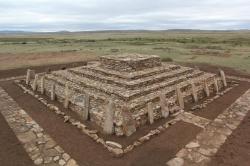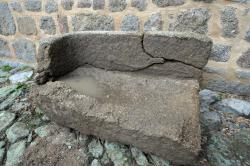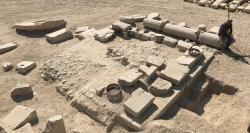INSTITUT SUPERIEUR D'ANTHROPOLOGIE
INSTITUTE OF ANTHROPOLOGY
ONLINE COURSES / COURS A DISTANCE
FALL TERM : OCTOBER 2017
REGISTER NOW
KAZAKHSTAN – 
 – Saryarka - Karaganda archaeologists have completed the reconstruction of the 3,000-year-old Saryarka pyramid, Kazinform reports with reference to archaeologist Viktor Novozhenov. According to him, the expedition was preparing the site for reconstruction all summer and recently the group led by the candidate of historical sciences, famous archaeologist Arman Beissenov completed the project. Archaeologists discovered the Bronze Age pyramid in August 2016. The mausoleum in Saryarka was built over 3,000 years ago.
– Saryarka - Karaganda archaeologists have completed the reconstruction of the 3,000-year-old Saryarka pyramid, Kazinform reports with reference to archaeologist Viktor Novozhenov. According to him, the expedition was preparing the site for reconstruction all summer and recently the group led by the candidate of historical sciences, famous archaeologist Arman Beissenov completed the project. Archaeologists discovered the Bronze Age pyramid in August 2016. The mausoleum in Saryarka was built over 3,000 years ago.
http://www.inform.kz/en/karaganda-archaeologists-complete-reconstruction-of-an-ancient-saryarka-pyramid_a3073011
JORDANIE - The oldest known monastery in Jordan is on Mount Nebo, a place which the Roman female pilgrim Egeria visited at the end of 4th century AD, said Jutta Häser. “We know about around 15 monasteries in the Byzantine period all over Jordan but probably there were more,” the German archaeologist, specialising in Near Eastern Archaeology, noted. Monasticism came from Egypt to Jordan, she explained, adding that monastic communities must have been an important part of society in the Byzantine period like in other regions. However, since we have only very few excavated sites and even less historical sources, it is hard to assess their relevance, Häser told The Jordan Times in a recent e-mail interview. “Most of the monasteries we know can be dated to the 5th to 7th century,” she continued, noting that “we know some sites by mosaic inscriptions which existed till the early 8th century”. The end of monasticism was caused by probably several reasons, she explained. “In the middle of the 8th century, the dynasty of the Umayyads was replaced by the Abbasids. During the following centuries, Islam increased throughout the region and regulations like the exclusion of Christians from high-ranking positions or wearing special clothes led Christians to conversion,” Häser explained. To better understand the monastic life in Jordan, different primary sources and material evidence are necessary, so in 2014, a mosaic inscription was rescued on Tell Ziraa, near Umm Qais in northern Jordan. “It was written in Greek with Greek characters. Since it was damaged, it remained only in parts,” she added. Italian scholar Andrea Zerbini dates the inscription to the year 709AD, Häser stressed, noting that another suggestion was made by Professor Niehoff, who dates it to the year 548AD. “The difference comes about the era used for determination, while archaeologically both dates are possible,” she noted. However, the inscription shows that monks built or renovated the building wherein the mosaic was found. “At the actual state of research, I think that we are dealing with a monastic complex; there are other building complexes of the same period on Tell Ziraa probably belonging to the monastery as well,” she highlighted. It is the largest monastic complex excavated in northern Jordan comparable to the one in Jabal Harun, the archaeologist pointed out. “Since there are many finds like pottery and glass vessels, stone and metal tools, we can reconstruct the daily life in such a community,” Häser added. Scholars can learn what monks ate and this information is also confirmed by the analysis of the animal bones found in the layer, she emphasised. “We can learn if they produced pottery by their own or if they imported it. If they have imported objects we can see from where these objects came from and the contacts these people had,” the researcher said. From the stone objects — especially from the mills and rubbing stones — researchers can see how they managed their life by agriculture (e.g. cereals, olive and wine), she underlined, adding that “if you have a lot of imported objects, the people on the hill must have something for exchange [e.g. wine and olive oil]”. “The building material and the workmanship show us if people were poor or rich,”Häser added.
http://www.jordantimes.com/news/local/german-scholar-explores-jordan%E2%80%99s-ancient-monasteries
INDE –  Bengaluru - In the early part of 21st century, Bengaluru was home to over 175 recorded stone inscriptions. Some of them date back to 5th century CE and give insights into the facets of the bygone era. But 70% of them are either lost or in bad shape. One such inscription was recently found in a drain near Hebbal. Studies show only about 30 of them are intact.
Bengaluru - In the early part of 21st century, Bengaluru was home to over 175 recorded stone inscriptions. Some of them date back to 5th century CE and give insights into the facets of the bygone era. But 70% of them are either lost or in bad shape. One such inscription was recently found in a drain near Hebbal. Studies show only about 30 of them are intact.
https://timesofindia.indiatimes.com/city/bengaluru/citizens-project-to-preserve-bengalurus-stone-inscriptions-that-tell-tales-of-bygone-era/articleshow/60997364.cms?
ROYAUME UNI –  Carlisle - Archaeologists were left stunned as the last day of the project this week saw them uncover a fantastically preserved series of bath-house drains and an inscription stone bearing the name of elite Roman cavalry unit once based at nearby Stanwix. The bath-house building found in the grounds of Carlisle Cricket Club was used by ala Petriana, the 1,000-strong unit that patrolled Hadrian's Wall. “This site has just been stunning,” said Frank Giecco, from the Wardell Armstrong archaeology firm which supervised the dig, helped by volunteers. “As the dig was coming to an end, we found one of the main drains that came out of the bath-house itself and the quality of the building is beautiful. We also found a tiny bit of a road, with huge kerbstones and cobbles. “But on Saturday we also found another inscription stone. “The early translation shows it's about ala Petriana – the first one ever found in Carlisle that mentions the cavalry regiment. We also found that one of the walls we uncovered which we'd thought was external is actually internal. “So the bath-house carries on further than we thought.
Carlisle - Archaeologists were left stunned as the last day of the project this week saw them uncover a fantastically preserved series of bath-house drains and an inscription stone bearing the name of elite Roman cavalry unit once based at nearby Stanwix. The bath-house building found in the grounds of Carlisle Cricket Club was used by ala Petriana, the 1,000-strong unit that patrolled Hadrian's Wall. “This site has just been stunning,” said Frank Giecco, from the Wardell Armstrong archaeology firm which supervised the dig, helped by volunteers. “As the dig was coming to an end, we found one of the main drains that came out of the bath-house itself and the quality of the building is beautiful. We also found a tiny bit of a road, with huge kerbstones and cobbles. “But on Saturday we also found another inscription stone. “The early translation shows it's about ala Petriana – the first one ever found in Carlisle that mentions the cavalry regiment. We also found that one of the walls we uncovered which we'd thought was external is actually internal. “So the bath-house carries on further than we thought.
http://www.newsandstar.co.uk/news/Last-minute-treasures-found-at-Roman-bath-house-show-site-is-of-national-significance-says-expert-7d4e92df-1dfd-453d-9205-4541ca31c410-ds
TURQUIE –  Uğurludağ - Archaeologists uncovered a 4,500-year-old male skeleton adorned with jewelry in the northern Turkish province of Çorum. The settlement under excavation, in the Uğurludağ village of Resuloğlu, is believed to have begun during the Early Bronze Age and continued through Seljuk and Ottoman periods. From the baked clay and metal gifts found in the grave site, archaeologists found out that the settlement's 300 residents were skilled in agriculture and mining. The style of weaponry suggests the community was of Caucasian and Mesopotamian origin. Based on necklaces, anklets and bracelets found on both male and female skeletons, Yıldırım suggested that the people of the settlement followed fashion trends, much like modern societies. The town of Resuloğlu is 50 kilometers from Alacahöyük, another Neolithic and Hittite site where the earliest examples of copper and stone tools were discovered. Systematic excavation of the royal tombs at Alacahöyük and Resuloğlu began in 2003.
Uğurludağ - Archaeologists uncovered a 4,500-year-old male skeleton adorned with jewelry in the northern Turkish province of Çorum. The settlement under excavation, in the Uğurludağ village of Resuloğlu, is believed to have begun during the Early Bronze Age and continued through Seljuk and Ottoman periods. From the baked clay and metal gifts found in the grave site, archaeologists found out that the settlement's 300 residents were skilled in agriculture and mining. The style of weaponry suggests the community was of Caucasian and Mesopotamian origin. Based on necklaces, anklets and bracelets found on both male and female skeletons, Yıldırım suggested that the people of the settlement followed fashion trends, much like modern societies. The town of Resuloğlu is 50 kilometers from Alacahöyük, another Neolithic and Hittite site where the earliest examples of copper and stone tools were discovered. Systematic excavation of the royal tombs at Alacahöyük and Resuloğlu began in 2003.
https://www.dailysabah.com/history/2017/10/09/4500-year-old-male-skeleton-found-in-northern-turkey
FRANCE –  Néoux - Les archéologues de l’Inrap sont allés de surprises en surprises à Néoux (Creuse), alors qu’ils intervenaient de manière préventive et ponctuelle avant des travaux. Et de 15 à Néoux, en Creuse! Quinze sondages, c’est ce qu’il a fallu jusqu’à mardi aux archéologues pour remonter le fil du temps. Et le chantier n’est pas totalement terminé. Pour un archéologue, nul n’est besoin de trouver une pièce d’or pour tomber sur un trésor ! Quelques céramiques sigillées blanches, des bouts de bois du Moyen-Âge, des sarcophages du VIIe siècle et des fonds d’amphores gauloises ont comblé Sylvain Guillin. Ces quelque sondages ont suffi à mettre au jour plusieurs époques d’occupation successives. « Ce que nous avons découvert est assez exceptionnel. » Pour plusieurs raisons. Pour la conservation des vestiges d’abord, l’étendue de l’occupation dans le temps et la surface. « Nous nous retrouvons face à 2.000 ans, en continu, avec beaucoup de vestiges gallo-romains. Les couches d’occupation ont été faciles à lire. Tout cela est plutôt rare en Creuse. Sylvain tient à nous montrer un fragment de sigillée qui reste blanc. « Ce qui est très rare. Tout comme le fait de retrouver des culs ou des anses d’amphores intactes. » L’équipe a également déterré du trachyte. « Cette roche volcanique est originaire du Puy-de-Dôme. Ils s’en servaient au VIIe siècle pour réaliser des sarcophages. » Mais les spécialistes n’étaient pas au bout de leur surprise. En sondant les abords de la belle église de Néoux, les archéologues ont retrouvé les traces d’un fossé défensif. « On avait des textes qui le mentionnaient mais il était impossible de dire où il était exactement. En deux sondages, on l’a retrouvé », développe Sylvain qui est un médiéviste. « J’ai l’habitude de fouiller des petits villages médiévaux. En général, au fil du temps, ils ont été remaniés. Ici, il n’y a pas eu de destruction mais un empilement. C’est intéressant. » Si ces objets sont aussi bien conservés, confie-t-il, c’est parce que la zone était humide. De plus on n’est pas très, très loin de l’ancienne voie gallo-romaine qui allait de Lyon à Saintes, la Via Agrippa.
Néoux - Les archéologues de l’Inrap sont allés de surprises en surprises à Néoux (Creuse), alors qu’ils intervenaient de manière préventive et ponctuelle avant des travaux. Et de 15 à Néoux, en Creuse! Quinze sondages, c’est ce qu’il a fallu jusqu’à mardi aux archéologues pour remonter le fil du temps. Et le chantier n’est pas totalement terminé. Pour un archéologue, nul n’est besoin de trouver une pièce d’or pour tomber sur un trésor ! Quelques céramiques sigillées blanches, des bouts de bois du Moyen-Âge, des sarcophages du VIIe siècle et des fonds d’amphores gauloises ont comblé Sylvain Guillin. Ces quelque sondages ont suffi à mettre au jour plusieurs époques d’occupation successives. « Ce que nous avons découvert est assez exceptionnel. » Pour plusieurs raisons. Pour la conservation des vestiges d’abord, l’étendue de l’occupation dans le temps et la surface. « Nous nous retrouvons face à 2.000 ans, en continu, avec beaucoup de vestiges gallo-romains. Les couches d’occupation ont été faciles à lire. Tout cela est plutôt rare en Creuse. Sylvain tient à nous montrer un fragment de sigillée qui reste blanc. « Ce qui est très rare. Tout comme le fait de retrouver des culs ou des anses d’amphores intactes. » L’équipe a également déterré du trachyte. « Cette roche volcanique est originaire du Puy-de-Dôme. Ils s’en servaient au VIIe siècle pour réaliser des sarcophages. » Mais les spécialistes n’étaient pas au bout de leur surprise. En sondant les abords de la belle église de Néoux, les archéologues ont retrouvé les traces d’un fossé défensif. « On avait des textes qui le mentionnaient mais il était impossible de dire où il était exactement. En deux sondages, on l’a retrouvé », développe Sylvain qui est un médiéviste. « J’ai l’habitude de fouiller des petits villages médiévaux. En général, au fil du temps, ils ont été remaniés. Ici, il n’y a pas eu de destruction mais un empilement. C’est intéressant. » Si ces objets sont aussi bien conservés, confie-t-il, c’est parce que la zone était humide. De plus on n’est pas très, très loin de l’ancienne voie gallo-romaine qui allait de Lyon à Saintes, la Via Agrippa.
http://www.lamontagne.fr/neoux/loisirs/science/2017/10/08/des-tresors-dhistoire-enfouis-sous-terre_12581784.html
EGYPTE – Louxor Rive gauche - Des archéologues égyptiens ont commencé à déblayer l'entrée du tombeau inconnu qu'ils ont trouvé sur la rive gauche du Nil, près de Louxor, informe Yoom 7, en citant le directeur du département des antiquités de Louxor, Talaat Abdul Aziz. «La porte d'entrée est endommagée par le temps. On mène des travaux pour déblayer l'entrée et pénétrer dans le tombeau afin de déterminer son âge et le nom de la personne pour qui il a été construit», a déclaré le directeur.
https://fr.sputniknews.com/culture/201710071033368558-Louxor-archeologie-Egypte-tombeau-chercheurs/
TURQUIE –  Tripolis - Archeologists have unearthed a 2,000-year-old olive oil mill in the ancient city of Tripolis in southwestern Turkey. Discovered in Turkey's Aegean province of Denizli, the mill is expected to shed light on the rich olive history of the region, according to Doğan News Agency. The mill was uncovered during the excavation of an ancient agora. The mill room measures 3.5 meters, with a stone press 50 centimeters in diameter used to crush the olives. "This mill, which we can say is 2,000 years old, shows us that in the past this region was rich in olive cultivation," stated Professor Bahadır Duman of Pamukkale University's Archeology Department and Tripolis Excavation Committee. Fifty columns were raised during the restoration of the agora, clearing the center area where the mill was discovered. Duman, who oversees the dig, reported that excavation will continue along with restoration of the agora.
Tripolis - Archeologists have unearthed a 2,000-year-old olive oil mill in the ancient city of Tripolis in southwestern Turkey. Discovered in Turkey's Aegean province of Denizli, the mill is expected to shed light on the rich olive history of the region, according to Doğan News Agency. The mill was uncovered during the excavation of an ancient agora. The mill room measures 3.5 meters, with a stone press 50 centimeters in diameter used to crush the olives. "This mill, which we can say is 2,000 years old, shows us that in the past this region was rich in olive cultivation," stated Professor Bahadır Duman of Pamukkale University's Archeology Department and Tripolis Excavation Committee. Fifty columns were raised during the restoration of the agora, clearing the center area where the mill was discovered. Duman, who oversees the dig, reported that excavation will continue along with restoration of the agora.
https://www.dailysabah.com/history/2017/10/05/2000-year-old-olive-oil-mill-uncovered-in-turkeys-aegean-region